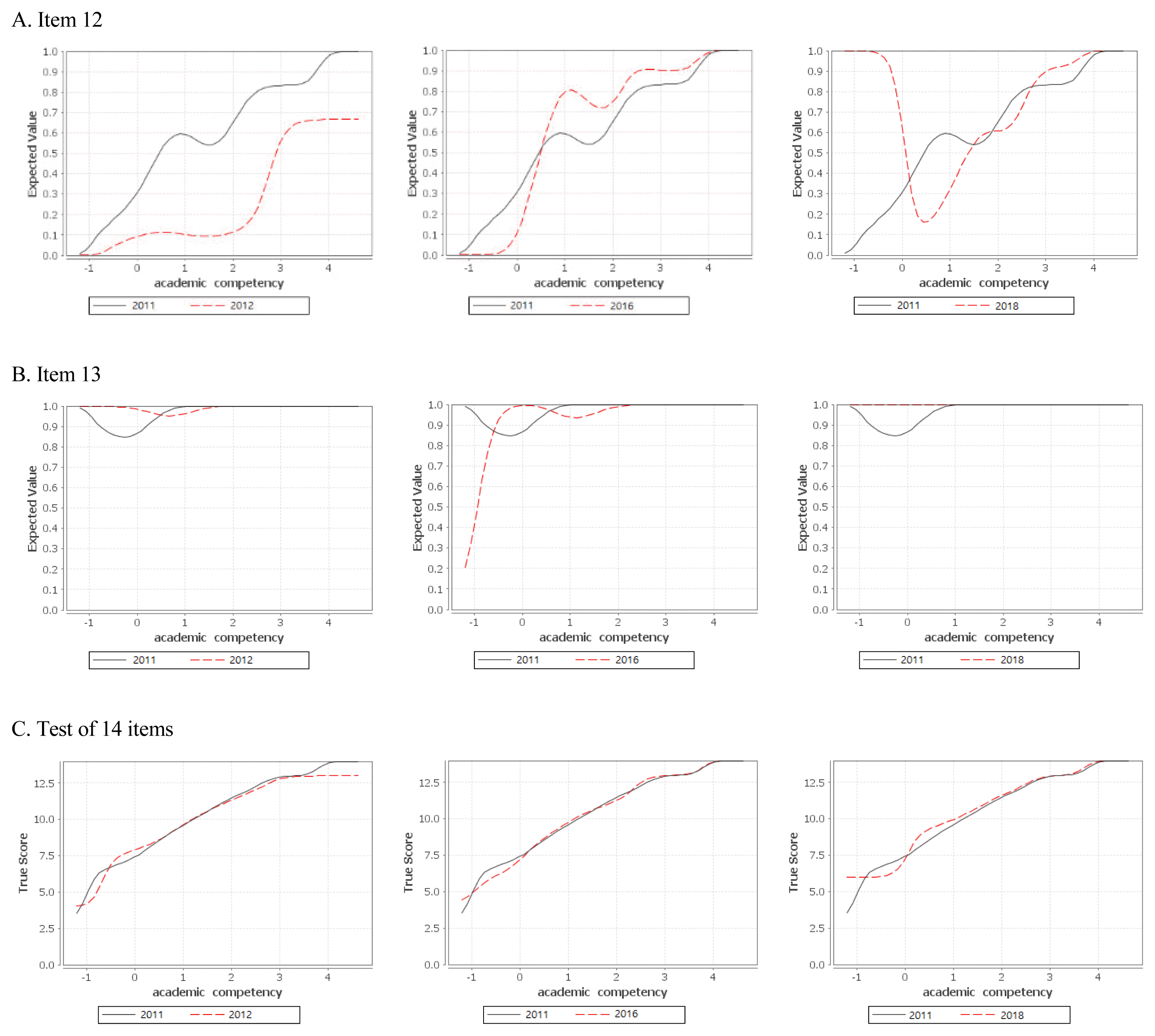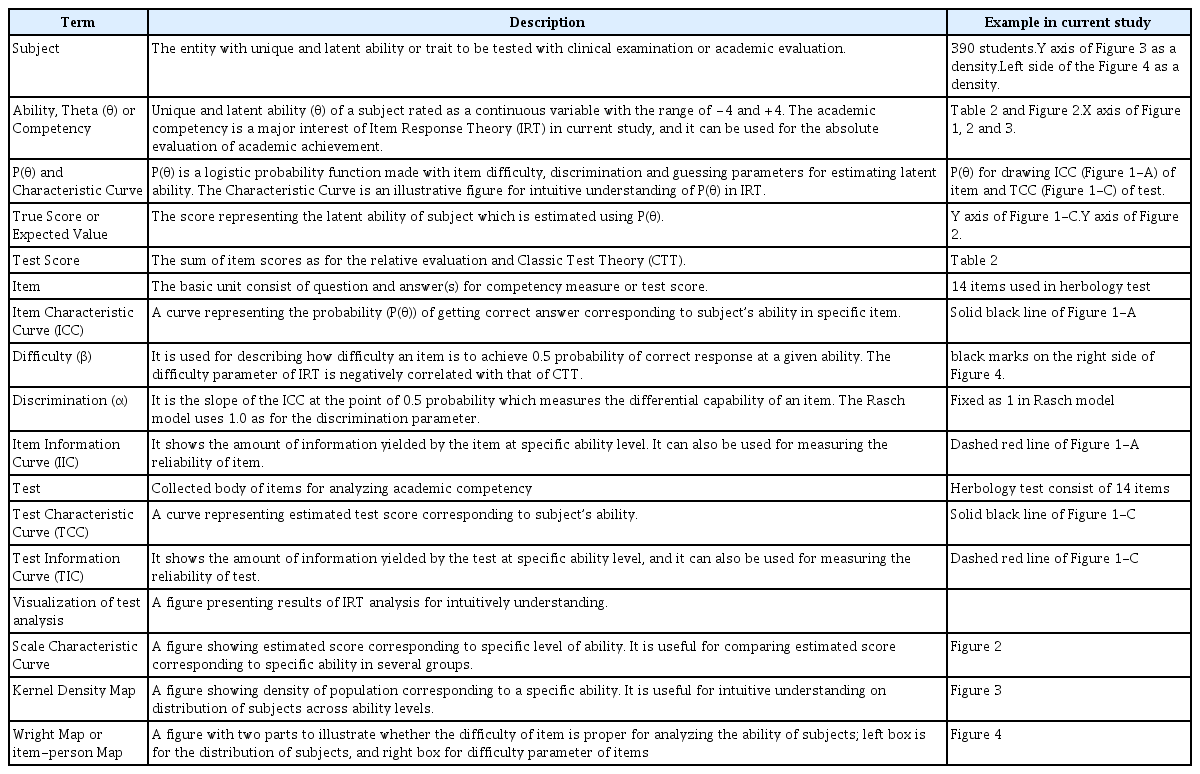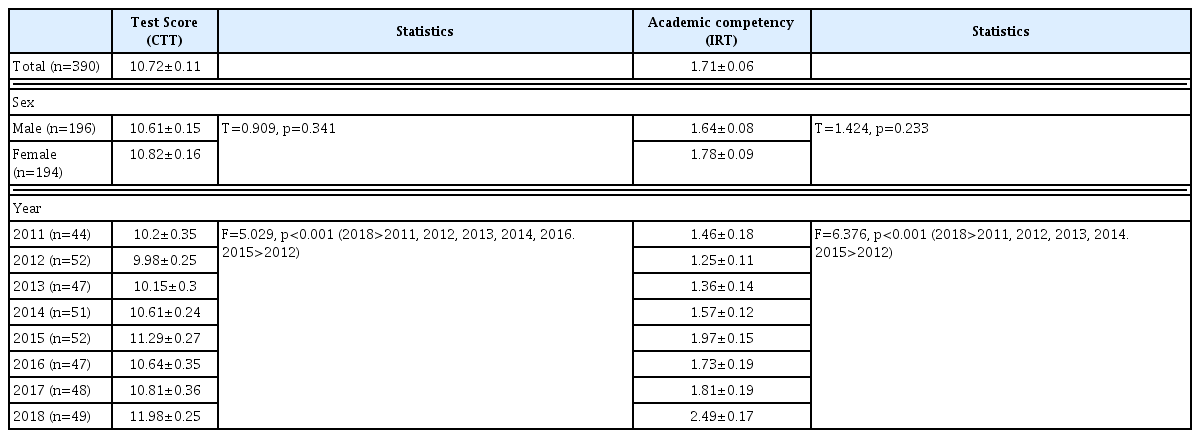References
2. Lee CK, Park JS, Lee E, Lee SJ, Park ES, Park YJ. 2001;A comparative study of item analysis by item response theory based for initiating cat (computer adaptive test) system. Korean J Med Educ 13(1):107–115.
3. Park JH, Son JY, Kim S. 2012;Experiences with establishing and implementing learning management system and computer-based test system in medical college. Korean J Med Educ 24(3):213–222.
https://doi.org/10.3946/kjme.2012.24.3.213
.
4. Im E-J, Lee W-K, Lee Y-C, Choe B-H, Chung S-K, Lee T-H, et al. 2008;Development of computer-based test (cbt) and student recognition survey on cbt. Korean J Med Educ 20(2):145–154.
https://doi.org/10.3946/kjme.2008.20.2.145
.
8. Meyer JP. 2014. Applied measurement with jmetrik New York: Routledge.
10. Chae H, Han SY, Yang G, Kim H. 2022;Study on the herbology test items in korean medicine education using item response theory. Kor J Herbology 37(2):13–21.
https://doi.org/10.6116/kjh.2022.37.2.13
.
11. Kim SH, Han SY, Kim JD, Choi S, Lee SJ, Lim JH, et al. 2015;Study on stress and burnout in medical education at the school of korean medicine. J Oriental Neuropsychiatry 26(2):103–116.
https://doi.org/10.7231/jon.2015.26.2.103
.
13. Schauber SK, Hecht M, Nouns ZM. 2018;Why assessment in medical education needs a solid foundation in modern test theory. Adv in Health Sci Educ 23(1):217–232.
https://doi.org/10.1007/s10459-017-9771-4
.
15. Chae H, Hwang S, Kwon Y, Baik Y, Shin S, Yang G, et al. 2010;Study on the prerequisite chinese characters for education of traditional korean medicine. J Physiol & Pathol Korean Med 24(3):373–379.
16. Lee Y, Kwak M-J, Jung H, Ha H-y, Chae H. 2012;A study on the statistical methods used in kci listed journals of traditional korean medicine from 1999 to 2008. Korea Journal of Oriental Medicine 18(2):55–64.
17. Lee J, Han JH, Kim MS, Lee HS, Han SY, Lee SJ, et al. 2020;Teaching yin-yang biopsychology using the animation, “pororo the little penguin”. Eur J Integr Med 33:101037.
https://doi.org/10.1016/j.eujim.2019.101037
.
18. Gray AC, Steel A, Adams J. 2019;A critical integrative review of complementary medicine education research: Key issues and empirical gaps. BMC Complement Altern Med 19(1):73.
https://doi.org/10.1186/s12906-019-2466-z
.
20. Schauber SK, Hecht M. 2020;How sure can we be that a student really failed? On the measurement precision of individual pass-fail decisions from the perspective of item response theory. Medical Teacher 42(12):1374–1384.
https://doi.org/10.1080/0142159X.2020.1811844
.
21. Lee SY, Lee Y, Kim MK. 2018;Effectiveness of medical education assessment consortium clinical knowledge mock examination (2011–2016). Korean Med Educ Rev 20(1):20–31.
https://doi.org/10.17496/kmer.2018.20.1.20
.
22. Lee S, Lee Y, Han SY, Bae N, Hwang M, Lee J, et al. 2020;Urinary function of the sasang type and cold-heat subgroup using the sasang urination inventory in korean hospital patients. Evid Based Complement Alternat Med 2020;:7313581.
https://doi.org/10.1155/2020/7313581
.
23. Chae H, Cho YI, Lee SJ. 2021;The yin-yang personality from biopsychological perspective using revised sasang personality questionnaire. Integr Med Res 10(1):100455.
https://doi.org/10.1016/j.imr.2020.100455
.
24. Lee Y-j, Lee S, Kim S-h, Lee J, Chae H. 2021;Study on the revision and clinical validation of the sasang digestive function inventory. J 33(3):54–71.
25. Park JC, Kim KS. 2012;A comparison between discrimination indices and item-response theory using the rasch model in a clinical course written examination of a medical school. Korean J Med Educ 24(1):15–21.
https://doi.org/10.3946/kjme.2012.24.1.15
.
26. Rasch G. 1960. Probabilistic models for some intelligence and attainment tests Danmarks Paedagogiske Institut.
27. Aksu G, GÜZELLER CO, Eser MT. 2019;Jmetrik: Classical test theory and item response theory data analysis software. Journal of Measurement and Evaluation in Education and Psychology 10(2):165–178.
https://doi.org/10.21031/epod.483396
.
28. Park JC, Kim KS. 2012;A comparison between discrimination indices and itemresponse theory using the rasch model in a clinical course written examination of a medical school. Korean J Med Educ 24(1)
https://doi.org/10.3946/kjme.2012.24.1.15
.
29. Han SY, Kim HY, Lim JH, Cheon J, Kwon YK, Kim H, et al. 2016;The past, present, and future of traditional medicine education in korea. Integr Med Res 5(2):73–82.
https://doi.org/10.1016/j.imr.2016.03.003
.
30. Yu J-S. 2019;Recommendation for development of clinical skill contents in the competency-based sasang constitutional medicine education. J Sasang Constitut Med 31(4):1–8.
https://doi.org/10.7730/JSCM.2019.31.4.1
.
32. Kim H-S, Yang U-h, Na C-s. 2018;A study on the perception of international healthcare development cooperation of korean medicine students for competency-based clinical herbology education. Kor J Herbology 33(5):39–46.
https://doi.org/10.6116/kjh.2018.33.5.39
.
33. Hong J, Kang Y. 2018;The implications of the case of medical education in north america on korean medicine education. The Journal of Korean Medical History 31(2):91–101.
https://doi.org/10.15521/JKMH.2018.31.2.091
.
35. Lee YB. 2013;The role of the concept of competence in korean outcome-based medical education. Korean Med Educ Rev 15(3):144–150.
36. Koschmann T. 1995;Medical education and computer literacy: Learning about, through, and with computers. Acad Med 70(9):818–821.
38. Naciri A, Radid M, Kharbach A, Chemsi G. 2021;E-learning in health professions education during the covid-19 pandemic: A systematic review. Journal of educational evaluation for health professions 18:27.
https://doi.org/10.3352/jeehp.2021.18.27
.






